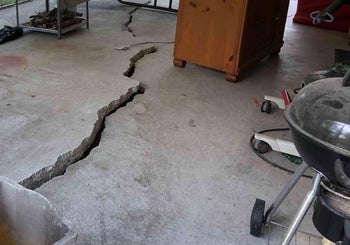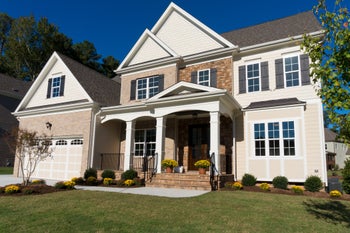House Jacks and How They’re Used
Table of Contents
1. What Is A House Jack (Screw Jack)?
2. How Are House Jacks Used?
3. Why Your Sagging Crawl Space Might Need House Jacks
4. Signs Your Home Might Need House Jacks
5. Tips On How To Prevent Foundation Trouble
Are you looking for information about house jacks (i.e, screw jacks or foundation jacks)? If so, don’t hit that back button because that’s what we’re going to talk about in this article. We’ll cover the basics of house jacks , how they’re used, why your home might need house jacks and more.
What Is A House Jack (Screw Jack)?
A house jack – also referred to as a “screw jack” and sometimes a “foundation jack”- is a device used to lift and level a sagging floor. House jacks are typically installed by foundation repair contractors and involve lifting the affected area of the foundation to support and stabilize it. If your crawl space foundation has sagging floors, screw jacks are an essential repair solution.
We don’t recommend homeowners install house jacks themselves as a DIY project. House jacks should only be installed by foundation repair professionals. If you suspect your crawl space foundation might need one or more house jacks, consult an expert to determine the best course of action for your situation.
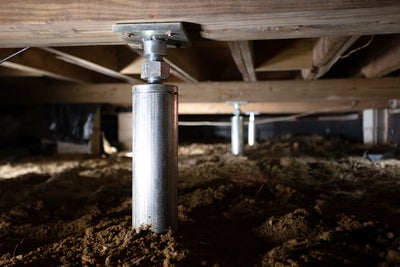
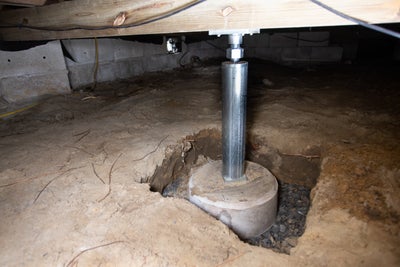

How Are House Jacks Used?
Foundation jacks are used to lift a sagging crawl space and provide reinforcement that prevents further sagging and settling. Before installing the house jacks, pier blocks are used as a base for the jacks to rest upon and distribute the weight evenly across the foundation. Once the jacks are in place, they are adjusted to the appropriate level to provide the necessary support. Usually, it takes more than one house jack to lift a sagging crawl space. House jacks are quick to install and adjustable in case the crawl space starts to sag again.
Why Your Sagging Crawl Space Might Need House Jacks
While crawl space foundations have been popular for decades because they offer easy access to the home’s plumbing and electrical wiring, they aren’t without their downsides. One of these is the tendency of crawl spaces to sag over time, for various reasons, including the following:
- One of the most common culprits is poor drainage around the foundation. When groundwater can’t drain away from your house as it should, the soil around the foundation can become waterlogged. This can cause the support posts in the crawl space to become non-vertical on the soggy dirt floor.
- Drainage issues can also cause trouble when the soil under the foundation contains a lot of clay. This soil type is referred to as “expansive” because it expands when it soaks up moisture and then shrinks when it dries out. This creates movement in the ground and can, over time, also cause crawl space support posts to become non-vertical.
- Existing house jacks, if not coated with something to protect them, can deteriorate over time as they’re exposed to moisture. Eventually, they’ll lose their ability to support the floor.
- Sometimes, the contractor who built the house didn’t include enough crawl space support piers. This can eventually cause the crawl space to sag. The solution is adding support through support piers or house jacks.
- Wooden crawl space support piers are susceptible to wood rot, which will negatively affect structural integrity.
Signs Your Home Might Need House Jacks
If you have a crawl space foundation, the following are common signs your home might need house jacks:
- Uneven, sagging, or bouncy floors
- Squeaky floors
- Your furniture shakes when you walk by.
- Cracked walls
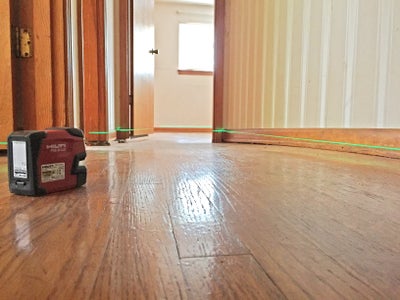
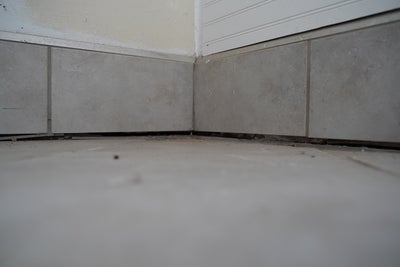

Tips On How To Prevent Foundation Trouble
Because most foundation issues are caused by excess moisture in the ground around the foundation, you can help prevent trouble by simply controlling groundwater around the home. Here are some ways to do that:
- If necessary, consider re-grading the yard around your home so that it slopes away from the foundation. You don’t want groundwater draining toward the foundation.
- Regularly clean your gutters of decaying organic matter and other debris. This will prevent runoff from spilling over the side of your home and down into the ground around the foundation.
- Install downspout extensions to carry runoff at least four feet from your home before release. Downspout extensions are inexpensive and easy to install.
- Relocate any water-hungry flowers or shrubs planted next to the home.
- Install a drain tile system. This is the best foundation waterproofing solution by far.
Foundation repair can be pretty costly. Implementing these preventative measures can save you time, frustration, and money in the long run.
If you think you’re home might need house jacks, contact Bay Area Underpinning today to schedule a foundation evaluation. If we find a problem, we’ll provide a repair estimate. We serve all of Northern California.
More Resources
Publish Date:
Last Modified Date:

Our Locations
2333 Courage Dr. Suite C
Fairfield, CA 94533
1161 N Fair Oaks Ave
Sunnyvale, CA 94089


